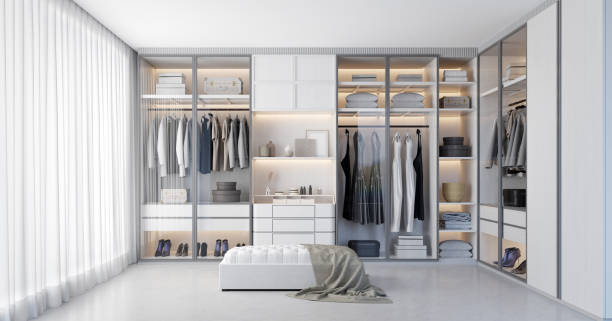Kids Weekly School Clothes Organization Hack for Busy Moms
If you spend mornings trying to figure out what the kids will wear, this hack is for you. Hanging closet organizer is the perfect way for children to build independence by planning out their own outfits for the week. Get ready for the week ahead by picking out your clothes ahead of time. The choices are endless!

Why Hanging Shelves Transform Morning Routines
Hanging shelves revolutionize children’s bedroom organization by maximizing vertical space while keeping clothes easily accessible. These versatile storage solutions attach to closet rods or wall-mounted systems, creating designated spaces for each day’s complete outfit. Unlike traditional dresser drawers that require bending and searching, hanging shelves position clothes at eye level for children, promoting independence and reducing parent intervention during morning preparations.
The visual organization system helps children understand daily routines while developing responsibility for personal belongings. Parents report significant time savings when clothes are pre-selected and arranged in hanging shelf systems, with many families reducing morning preparation time by 15-20 minutes daily.
Benefits of a 5-Shelf Weekly Clothes Organizer for Kids
A 5-shelf weekly clothes organizer for kids provides dedicated space for Monday through Friday outfits, creating a clear visual system that children can easily follow. Each shelf accommodates complete outfit sets including tops, bottoms, underwear, and socks, eliminating the guesswork from daily clothing selections.
This organizational approach reduces decision fatigue for both parents and children while ensuring weather-appropriate clothing choices are made in advance. The system works particularly well for elementary school children who thrive with structured routines and visual organization cues.
Many families find that weekend outfit planning becomes a fun family activity, allowing children to participate in clothing selection while parents maintain final approval for appropriateness and weather considerations. The 5-shelf system also helps parents monitor laundry needs and identify clothing gaps before they become problems.
Choosing the Right Clothes Organizer for Your Family
Effective clothes organizer selection depends on available space, child age, and family lifestyle factors. Fabric hanging organizers work well for lightweight clothing and temporary solutions, while sturdy mesh or canvas options provide durability for daily use. Consider organizers with clear pockets or open shelves that allow children to see contents without handling multiple items.
Size considerations include shelf depth for folded items and height placement for child accessibility. Most successful systems position organizers within children’s natural reach range, typically 24-48 inches from floor level depending on age. Adjustable hanging systems accommodate growing children and changing clothing sizes throughout the school year.
Quality organizers feature reinforced stitching, sturdy hanging mechanisms, and easy-to-clean materials that withstand regular use. Some families prefer multiple smaller organizers for different clothing categories, while others opt for single comprehensive units that house complete weekly wardrobes.
Setting Up Your Weekly Organization System
Successful weekly clothes organization begins with Sunday planning sessions involving age-appropriate child participation. Start by checking the weekly weather forecast and school activity calendar to ensure appropriate outfit selections. Lay out five complete outfits including undergarments, socks, and any special items needed for specific school activities.
Place Monday’s outfit in the top shelf position, followed by Tuesday through Friday in descending order. This top-to-bottom system creates an intuitive flow that children quickly understand and follow independently. Include any special accessories, hair items, or school-specific requirements with each day’s outfit.
Consider creating a simple checklist system for children to mark off completed dressing tasks, building confidence and routine adherence. Many families find that involving children in the planning process increases compliance and reduces morning resistance to clothing choices.
| Organizer Type | Material | Price Range | Best For |
|---|---|---|---|
| Fabric Hanging Organizer | Canvas/Polyester | $15-$30 | Lightweight clothes, temporary use |
| Mesh Hanging Shelves | Breathable mesh | $20-$40 | Athletic wear, quick-dry items |
| Clear Pocket Organizer | Vinyl/Plastic | $25-$45 | Visual organization, multiple items |
| Wooden Shelf Inserts | Wood/Metal frame | $40-$80 | Heavy items, permanent installation |
Prices, rates, or cost estimates mentioned in this article are based on the latest available information but may change over time. Independent research is advised before making financial decisions.
Maintaining Long-Term Organization Success
Sustainable clothes organization requires consistent weekly routines and periodic system adjustments. Schedule regular organization sessions to accommodate seasonal clothing changes, growth spurts, and evolving style preferences. Most families find that maintaining the system becomes easier over time as children develop independence and routine adherence.
Address organization challenges promptly by adjusting shelf heights, replacing worn organizers, or modifying the system based on changing family needs. Consider seasonal rotation strategies that keep current weather-appropriate clothing accessible while storing off-season items separately.
Regular evaluation of the system’s effectiveness helps identify improvement opportunities and ensures continued success. Many families discover that organizational skills developed through clothes management transfer to other areas of children’s responsibilities, creating broader benefits beyond morning efficiency.
Weekly clothes organization systems provide busy families with practical solutions for reducing morning stress while teaching children valuable life skills. By implementing hanging shelves and structured organizers, parents create sustainable routines that benefit entire households through improved time management and increased child independence.




